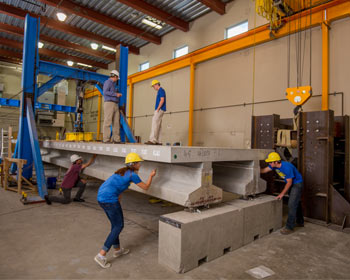MPC
Research update: Developing alternatives to the double-tee bridge system
Posted: Dec 19, 2016
 Precast double-tee bridge deck systems are currently used for local roads in South Dakota. Alternative durable precast or prefabricated bridge systems are needed to provide more options to local governments when designing a new bridge.
Precast double-tee bridge deck systems are currently used for local roads in South Dakota. Alternative durable precast or prefabricated bridge systems are needed to provide more options to local governments when designing a new bridge.
MPC researchers Dr. Nadim Wehbe, Dr. Mostafa Tazarv, and graduate student Michael Mingo at South Dakota State University investigated the feasibility of alternative prefabricated bridge systems, including precast full-depth deck panels on prestressed inverted bulb-tee girders. Similar systems have been studied by other investigators, but the precast decks in those systems required post-tensioning. The system proposed in this study does not require post-tensioning of the deck, thus making the system simple and easy to assemble in the field without the need for highly skilled labor.
Different alternatives will also give local governments more flexibility to select the best system by comparing performance, availability, and cost of different options.
The researchers designed, constructed and tested a full scale sub-assemblage of the proposed alternative bridge system at the Lohr Structures Lab at SDSU. The prototype bridge system was designed based on a 50-ft long by 34.5-ft wide prototype bridge. The full-scale test bridge specimen was 50-ft long by 9.5-ft wide representing two interior girders from the prototype bridge.
The bridge was first tested under 500,000 cycles of the AASHTO Fatigue II loading using a point-load applied at the mid-span. Next, the performance of transverse joints was evaluated by applying 150,000 AASHTO Fatigue II load cycles using two point loads applied adjacent to the middle panel transverse joints to maximize the shear transfer. Stiffness tests were performed at every 50,000 load cycle interval for both fatigue tests. No significant damage was observed through the entire fatigue test and the overall bridge stiffness did not show any signs of deterioration. Finally, the proposed bridge system was monotonically loaded to 263 kips to investigate the ultimate capacities. It was shown that the first crack loading magnitude was higher than the equivalent AASHTO Service and Strength I limit states, indicting sufficient performance. Additionally, the construction technique used in the lab can be implemented in the field without the need for highly skilled labor.
The study was co-funded by MPC, SDDOT, and Gage Bros. Inc. in Sioux Falls, SD.

